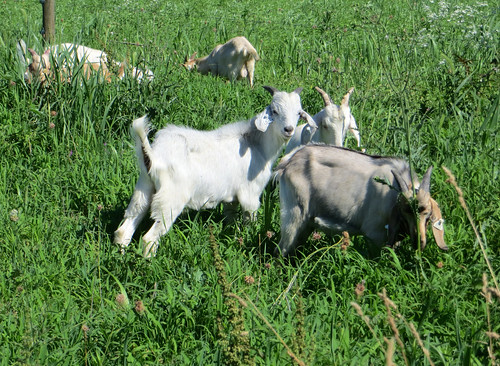Eighty-four (84) bucks are participating in this year's Western Maryland Pasture-Based Meat Goat Performance Test. They are all Kiko or Kiko-influenced. The Kikos are a combination of New Zealand, purebred, "composite," and commercial.
As for other "breeds," there is one 3/4 Boer and two half Boers in the test. There is a Kiko Genemaster. Only one buck was described as crossbred. There are several high percentage Kiko crosses in the test.
Upon arrival to the test site the bucks ranged in age from 103 to 170 days and averaged 131 + 20 days. The median age was 128 days. The average birth date was February 15 + 20 days. The median birth date was February 18.
Birth type ranged from 1 (single) to 4 (quad) and averaged 2.1. The median birth type was 2.0 (twin). Birth weights ranged from 5.1 to 10.6 lbs. and averaged 7.5 + 1.2 lbs. The average age at weaning was 88.3 + 12.9 days; the median was 88 days. Weaning age ranged from 59 to 126 days. The bucks were produced by dams that ranged in age from 1 to 9 years. The average age of dam was 4.0 + 1.7 years. The median dam age was 4 years. Twenty-six percent of the bucks were creep fed.
Using the data provided, a weight per day of age (WDA, at start of test), pre-weaning ADG, corrected 90-day weaning weight, adjusted 90-day weaning weight, and weaning weight ratio was calculated for each buck. Since the goats were weaned (and weighed at different ages), weights had to be equalized to a common age (90 days). To minimize the effects of environment on performance, weights had to be adjusted for birth type and type of rearing and age of dam.The standard of comparison is a single-born and raised kid, born to a mature doe, 3 years of age and older.
WDA, pre-weaning ADG, corrected 90-day weaning weights, adjusted 90-day weaning weights, and weaning weight ratios are provided for informational purposes only. Data can only be compared among bucks in the same consignment and for such a comparison to be made, we are assuming that all kids were fed and managed the same.
Differences in pre-weaning performance between bucks from different consignments are due to differences in environment (feed and management), not necessarily genetics; they cannot be compared. To make across-herd comparisons, it is necessary to have EBVs (estimated breeding values) calculated by the National Sheep Improvement Program (NSIP) or a similar genetic evaluation program.
It is the purpose of this buck test to determine post-weaning genetic differences between bucks from different farms. These comparisons are valid because the bucks now share a common environment. Every buck is fed and managed in the same manner.
Download detailed buck information report
As for other "breeds," there is one 3/4 Boer and two half Boers in the test. There is a Kiko Genemaster. Only one buck was described as crossbred. There are several high percentage Kiko crosses in the test.
 |
| All bucks in the test have Kiko blood. |
Upon arrival to the test site the bucks ranged in age from 103 to 170 days and averaged 131 + 20 days. The median age was 128 days. The average birth date was February 15 + 20 days. The median birth date was February 18.
Birth type ranged from 1 (single) to 4 (quad) and averaged 2.1. The median birth type was 2.0 (twin). Birth weights ranged from 5.1 to 10.6 lbs. and averaged 7.5 + 1.2 lbs. The average age at weaning was 88.3 + 12.9 days; the median was 88 days. Weaning age ranged from 59 to 126 days. The bucks were produced by dams that ranged in age from 1 to 9 years. The average age of dam was 4.0 + 1.7 years. The median dam age was 4 years. Twenty-six percent of the bucks were creep fed.
Using the data provided, a weight per day of age (WDA, at start of test), pre-weaning ADG, corrected 90-day weaning weight, adjusted 90-day weaning weight, and weaning weight ratio was calculated for each buck. Since the goats were weaned (and weighed at different ages), weights had to be equalized to a common age (90 days). To minimize the effects of environment on performance, weights had to be adjusted for birth type and type of rearing and age of dam.The standard of comparison is a single-born and raised kid, born to a mature doe, 3 years of age and older.
 |
| A common environment is needed to make comparisons. |
WDA, pre-weaning ADG, corrected 90-day weaning weights, adjusted 90-day weaning weights, and weaning weight ratios are provided for informational purposes only. Data can only be compared among bucks in the same consignment and for such a comparison to be made, we are assuming that all kids were fed and managed the same.
Differences in pre-weaning performance between bucks from different consignments are due to differences in environment (feed and management), not necessarily genetics; they cannot be compared. To make across-herd comparisons, it is necessary to have EBVs (estimated breeding values) calculated by the National Sheep Improvement Program (NSIP) or a similar genetic evaluation program.
It is the purpose of this buck test to determine post-weaning genetic differences between bucks from different farms. These comparisons are valid because the bucks now share a common environment. Every buck is fed and managed in the same manner.
Download detailed buck information report











